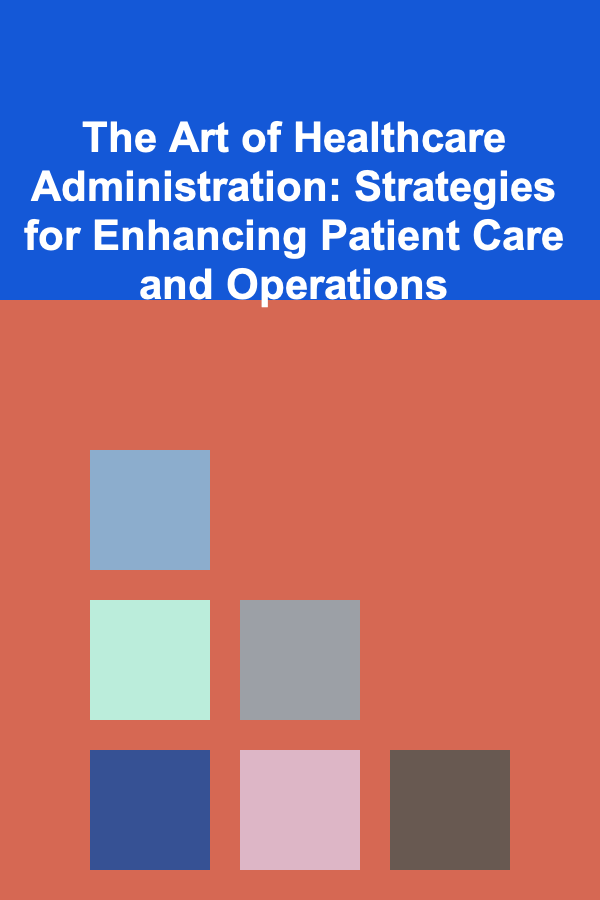
The Art of Healthcare Administration: Strategies for Enhancing Patient Care and Operations
ebook include PDF & Audio bundle (Micro Guide)
$12.99$6.99
Limited Time Offer! Order within the next:

Healthcare administration is a complex, multifaceted discipline that blends management practices with patient care strategies. As healthcare systems grow increasingly intricate, the role of administrators becomes even more pivotal in ensuring the quality, efficiency, and sustainability of services. Effective healthcare administrators must navigate a labyrinth of regulatory requirements, financial constraints, technological advances, and evolving patient needs, all while maintaining a focus on delivering exceptional care.
In this guide, we explore actionable strategies for healthcare administrators to improve both patient care and operational efficiency. These strategies range from optimizing workflows and implementing evidence-based practices to fostering a culture of leadership and innovation. Let's dive into the key principles that can help transform healthcare administration for better outcomes.
Leadership Development and Team Empowerment
At the heart of successful healthcare administration is strong leadership. Healthcare administrators should focus on developing their leadership skills, as well as empowering their teams. An effective leader in healthcare not only manages day-to-day operations but also sets the vision and fosters a culture of collaboration.
Actionable Tips:
- Cultivate Emotional Intelligence (EQ): Strong leaders are empathetic, self-aware, and skilled at managing their emotions. Training in EQ helps leaders connect with staff, navigate difficult situations, and build trust within their teams.
- Encourage Autonomy: Empower staff members to make decisions within their roles. When employees feel trusted, they are more likely to take initiative and contribute to the organization's goals.
- Lead by Example: Exhibit the behaviors you want to see in your team. Whether it's punctuality, respect, or innovation, leaders set the tone for the workplace environment.
Effective leadership is not just about setting goals---it's about creating a work culture that encourages teamwork, resilience, and personal growth.
Streamlining Administrative Processes for Operational Efficiency
In a healthcare setting, operational efficiency directly impacts the quality of care. Administrators must focus on reducing redundancies, optimizing workflows, and ensuring that resources are allocated where they are most needed. A well-organized administrative system improves patient care, enhances staff satisfaction, and reduces costs.
Actionable Tips:
- Implement Lean Management Techniques: Adopt lean principles to reduce waste and streamline processes. Identifying areas where time and resources are underutilized can lead to significant improvements in workflow.
- Use Data Analytics: Leverage technology and data analytics to assess operational performance. Data can highlight bottlenecks, delays, or inefficiencies that are hindering productivity and patient care.
- Automate Routine Tasks: Use automation tools to handle routine administrative tasks like scheduling, billing, and patient records management. This frees up time for staff to focus on more meaningful interactions with patients.
Streamlining operations not only improves efficiency but also reduces stress on staff members and ensures that patients receive timely and effective care.
Improving Communication Across Departments
Communication is a critical element in any healthcare setting. Inefficient communication between departments can result in errors, delays, and poor patient outcomes. Healthcare administrators need to foster clear, concise, and open communication both among staff and with patients.
Actionable Tips:
- Implement Standardized Communication Protocols: Tools like SBAR (Situation, Background, Assessment, Recommendation) can improve communication between clinicians and administrators. This framework ensures that key information is communicated clearly and concisely, reducing the risk of misunderstandings.
- Foster Open Channels for Feedback: Encourage staff to provide feedback about communication challenges. Regular check-ins, surveys, and anonymous suggestion boxes can help identify communication breakdowns.
- Invest in Technology Solutions: Platforms like Electronic Health Records (EHRs) and patient management systems improve communication between departments and ensure that important patient information is readily available to all relevant parties.
Clear communication is the backbone of any high-functioning healthcare organization. Administrators should foster an environment where information flows seamlessly, leading to better care coordination and improved patient satisfaction.
Promoting Patient-Centered Care
Patient-centered care is not just a trend but a necessity for ensuring better health outcomes and greater patient satisfaction. Administrators must create systems and cultures that prioritize the needs, preferences, and values of patients while maintaining high clinical standards.
Actionable Tips:
- Engage Patients in Decision-Making: Encourage shared decision-making, where patients actively participate in discussions about their care plans. This increases patient satisfaction and leads to better compliance with treatment.
- Implement Patient Feedback Systems: Regularly collect and analyze patient feedback through surveys, interviews, and social media. This data can guide improvements in service delivery and care quality.
- Train Staff in Empathy and Compassion: Patient care is not just about medical procedures---it's also about emotional support. Ensure that staff members receive training in empathy, communication, and conflict resolution.
By emphasizing patient-centered care, healthcare administrators can ensure that services are not only effective but also personalized, leading to better outcomes and a more positive patient experience.
Leveraging Technology for Better Care Delivery
Technological innovations in healthcare administration offer vast potential for improving care delivery. Whether it's using telemedicine to reach remote patients or employing AI-driven diagnostic tools, technology can enhance both patient care and operational efficiency.
Actionable Tips:
- Adopt Telemedicine Platforms: Telemedicine expands access to care, particularly for rural or underserved populations. Integrating telehealth services into your practice can reduce wait times, increase access to specialists, and lower costs.
- Invest in AI and Machine Learning: AI can be used for predictive analytics, helping healthcare administrators identify at-risk patients, optimize staff scheduling, and improve resource allocation.
- Streamline Patient Access Through Portals: Patient portals allow individuals to access their medical records, request prescriptions, and schedule appointments online. These tools improve patient convenience and reduce administrative burdens.
Healthcare administrators must stay ahead of technological trends to ensure their organizations are equipped to provide the best possible care in an ever-evolving landscape.
Managing Financial Sustainability
One of the most challenging aspects of healthcare administration is managing financial sustainability. With rising costs, limited budgets, and complex billing processes, healthcare administrators must develop strategies to balance financial viability with quality care.
Actionable Tips:
- Optimize Revenue Cycle Management: Streamline billing and coding processes to reduce errors and expedite reimbursement. This includes regularly reviewing coding practices, improving claim submissions, and following up on denied claims.
- Monitor Financial Key Performance Indicators (KPIs): Keep track of important financial metrics like cost per patient, operating margins, and payer mix to identify areas where financial performance can be improved.
- Develop Cost-Effective Care Models: Explore value-based care models, where reimbursement is based on the quality of care provided rather than the volume of services. This can improve both patient outcomes and financial sustainability.
Effective financial management is critical for ensuring that healthcare organizations can continue providing high-quality care without compromising their financial health.
Adapting to Regulatory Changes and Compliance
The healthcare industry is subject to constantly changing regulations and compliance requirements. Administrators must stay updated on these changes to avoid legal and financial penalties while ensuring that patient care remains uncompromised.
Actionable Tips:
- Stay Informed About Regulatory Changes: Regularly attend workshops, seminars, and industry events to keep up with regulatory changes at the local, state, and federal levels.
- Implement Compliance Training Programs: Ensure that all staff members, from clinicians to administrative personnel, are aware of their responsibilities regarding regulatory compliance.
- Use Compliance Management Software: Invest in software that helps track regulatory requirements and compliance standards, ensuring that nothing is overlooked.
Adapting to regulatory changes is a continuous process that requires vigilance, training, and collaboration across the organization.
Building a Strong Organizational Culture
A healthy organizational culture enhances employee satisfaction, reduces turnover, and leads to better patient care. Healthcare administrators must create an environment where staff members feel supported, valued, and motivated.
Actionable Tips:
- Foster a Culture of Collaboration: Encourage teamwork between different departments. When staff collaborate and communicate effectively, patient care improves, and operational goals are met more efficiently.
- Recognize and Reward Staff: Implement recognition programs to celebrate staff achievements, whether through awards, promotions, or public acknowledgment. This helps maintain morale and encourages excellence in performance.
- Invest in Staff Development: Offer opportunities for professional development, including continuing education, leadership training, and mentorship programs. This not only benefits the staff but also improves the quality of care they provide.
A positive organizational culture is essential for retaining skilled staff and maintaining a high level of care. Administrators must actively cultivate this environment to ensure long-term success.
Conclusion
The art of healthcare administration requires a delicate balance between managing operations and enhancing patient care. Administrators who embrace strong leadership, optimize operations, foster clear communication, and remain adaptable to changes in technology and regulations are well-positioned to create thriving healthcare environments. By focusing on the key strategies outlined in this guide, healthcare administrators can drive both operational success and improved patient outcomes, ultimately contributing to the overall well-being of the communities they serve.

How to Dress for Success: The Ultimate Guide to Interview Attire
Read More
How to Plan a Stress-Free Home Party
Read More
How to Upsell Products and Services in Your Beauty Salon Business: An Actionable Guide
Read More
Practical Strategies for Reducing Medical Expenses and Managing Healthcare Costs
Read More
How to Create an Evening Routine for a Restful Night
Read More
Lifelong Learning: A Step-by-Step Path
Read MoreOther Products

How to Dress for Success: The Ultimate Guide to Interview Attire
Read More
How to Plan a Stress-Free Home Party
Read More
How to Upsell Products and Services in Your Beauty Salon Business: An Actionable Guide
Read More
Practical Strategies for Reducing Medical Expenses and Managing Healthcare Costs
Read More
How to Create an Evening Routine for a Restful Night
Read More